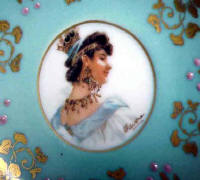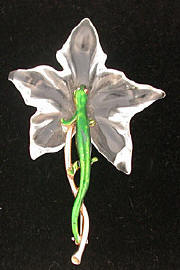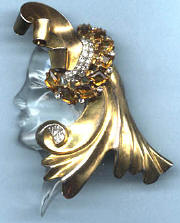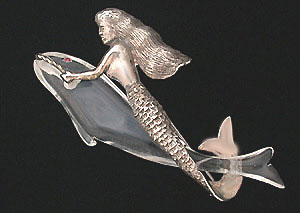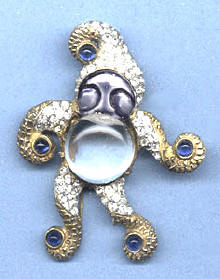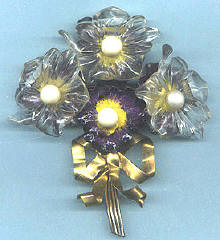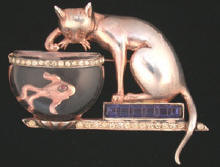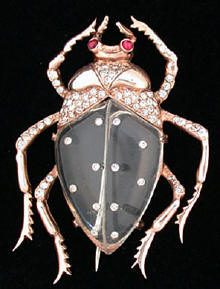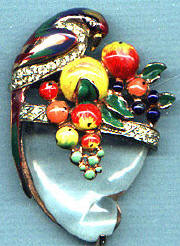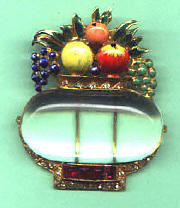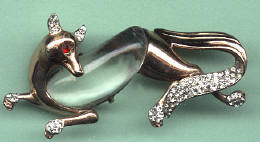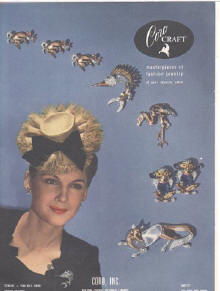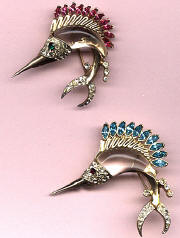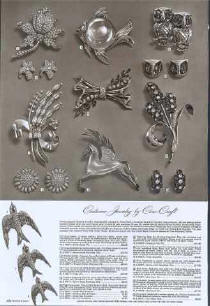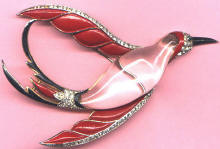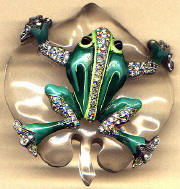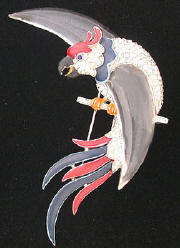|
|
|
THE COLLECTORS
JELLY BELLY
courtesy of Brenda Nurenberg
of Vintage Treasures
|
Brenda is a long-time collector of marvelous Lucite jewelry, also referred to as "jelly bellys", and her
enthusiasm is contagious. These wonderful pieces were made in the 1930’s and
1940’s of rhinestones, metals and the newly-invented Lucite (NOT glass). Their
creative and imaginative designs make them eagerly sought after by
collectors and dealers alike.
Brenda says, "One of my first books on costume Jewelry was Fun
Jewelry. This book had so many jelly bellies pictured. I fell in love
with them and I was hooked. I immediately went hunting in my local antique
mall and came up with the tiniest of turtles. I thought I had made a major
find! That was the beginning of a wonderful collection."
|
|
"JELLY BELLY" jewelry
Named for their clear transparent Lucite bellies, "jelly bellys" can be both beautiful and whimsical. Most were made in the 1940’s,
although some continued to be produced into the early 1960’s. Collector’s
usually agree that in order to qualify as a true "jelly belly", the belly
portion must be made of Lucite, not glass, and must be clear, not colored,
and set in metal.
The most coveted pieces are larger pieces with Lucite set in sterling vermeil (gold washed
sterling).
Since jelly bellys all have a Lucite component and Lucite was invented by DuPont in 1937,
there are no
jelly bellys are older than that. Says jewelry historian Pat Seal, "I
doubt if any were made much before 1938 and the bulk of them were made
during the war years, 1942-1946. Many of the ones of that era were made in
sterling silver settings. After the war and into the 1950’s they were made
in base metals, but all of them are delightful!" There are many
reproductions so buy from an honest and knowledgeable dealer. (See more
information on the source myth at the bottom of this page.)
For more jelly belly jewelry at Morning Glory
Collects, click HERE
And to BUY jelly belly pieces, please click HERE.
|
|
FLORAL
This is a very striking 2-1/2" floral brooch made of pot metal and Lucite.
The rose head is very chunky, heavy and very three-dimensional. |
FLOWER This is a
stunning flower bouquet. It is a large gold tone unsigned 4"
with three carved Lucite flower heads centered with clear rhinestones. Circa
1940. |
DOUBLE FLOWER a large unsigned 3-1/2" floral brooch with two Lucite flowers and
clear rhinestone accents set in gold plated pot metal, circa 1942. |
|
FLOWER
& LIZARD A very unusual unsigned flower pin with a green lizard
crawling up its stem. What imagination! Gold tone, 3.5", probably
circa 1940.
|
FRED
A BLOCK It measures 4" and is signed "Fred A. Block Jewelry", gold
tone pot metal. The face shows wonderful detail. This is my favorite. From
the first time that I saw it in one of the jewelry books, I was determined
to own it.
Back View |
MERMAID riding on a Lucite
fish 2" brooch, a smallish but very unusual sterling unsigned jelly. I
think it might have had a vermeil finish at one time but if so, it is worn
off now. It is simply
marked "sterling". |
|
SANDOR 2" fur clip
signed "Sandor", it is gold tone and although the metal looks and cleans
like sterling, it is not marked sterling. The face is ceramic.
My husband thinks this is one of the ugliest in my collection. I have always called
him "The Sandman" but one of the books calls him the gnome and another the
snowman. |
SANDOR This is
the largest jelly that I own. It is a whopping 5". It is signed "Sandor",
gold tone with three Lucite flower heads and a fourth flower head that is
enameled metal. Large pearls in the center of the flower heads.
|
CAT & FISHBOWL
signed "Anthony" and "Sterling", this 2-1/2" brooch is sterling vermeil. The
goldfish behind the Lucite bowl is made of metal. There are two versions of
this pin, and the other one is unsigned, made of pot metal and the fish is
carved into the Lucite. |
PATENT 1946
Patent No. 149,925 |
|
HORSE
This 2-1/2" horse brooch is one of my most recent purchases. It is unsigned
pot metal, and is missing its enamel. |
LLAMA This is a 2-1/4"
unsigned but charming fur clip, 2-1/4". He is a llama with a gilt silver
saddle. |
PRANCING HORSE
This is one of the jelly bellies that I bought in London. The entire
horse is Lucite except for the saddle and reins. It is attached on the
back to a metal frame that is in the same shape as the horse and is gold
tone. Unsigned but marked Sterling, 4". Circa 1942.
|
|
SPIDER A very realistic
2-1/2" unsigned spider pin. It is sterling but the vermeil has worn
away. Clear rhinestones accent the legs. I love to perch him on my shoulder. |
CORO PEGASUS Sterling
2" brooch with a rose gold vermeil. Signed "Corocraft Sterling", it was
also the logo of Coro Company. This one of my first jellies found in New
York City almost 10 years ago. I had no idea at the time how rare it was,
and in fact it was something of a bargain. Patent number 139,072 dated 1949. |
COROCRAFT sterling and rose
gold vermeil 2-1/2" beetle brooch with imbedded rhinestones. My
favorite creepy crawly.
|
|
COROCRAFT sterling
cornucopia 2" brooch with vibrant enamel fruit and perching bird,
circa 1944. Be careful because while this is genuine, it has been reproduced
in the 1990s.
|
TRIFARI 2-1/4" sailboat brooch, a realistic boat with Lucite sail set in
sterling/gold vermeil. Signed "Trifari Sterling". |
COROCRAFT sterling 2" fur
clip with bright enamel fruit atop a Lucite vase, circa 1944. Be careful
because while this is genuine, it has been reproduced in the 1990s. |
|
TRIFARI big elephant
rhodium-plated 3" fur clip with Lucite body, clear rhinestones and red and
black enamel. Signed "Trifari Pat. Pend."
View back |
TRIFARI PEKINESE rhodium
plated 2-1/2" brooch with black enamel and clear rhinestones, signed
"Trifari Pat. Pend.". Be careful because while this is genuine, it
has been reproduced in the 1990s.
View back |
MONKEY brooch, an unsigned
favorite. Rambunctious 2" monkey pin in sterling with a gold
vermeil. |
|
CORO fox jelly belly shown
in ad at right, circa 1945.
Courtesy of Brenda Nurenberg |
CORO 1945 ad
showing "jellly bellies". |
CORO fish
jelly belly shown in ad at left.
Courtesy of Brenda Nurenberg |
COROCRAFT "Jelly Bellies"
1943 |
|
TRIFARI A rare
jelly belly that is one of my favorites. I call him "Big Bird". Gold
tone pot metal bird with red and blue enamel and Lucite body. A
whopping 4.5 inches in size. I have also seen this done in blue enamel.
Back View |
TRIFARI FROG on Lily Pad,
a large Lucite leaf with an enamel frog stretched out on top. Rhodium plated,
signed "Trifari Pat. Pend", 2-3/4".
I have seen the
reproduction of this piece and while, unlike the real piece, the jelly part
is flat, the front is quite good.
Back View |
PARROT perched on a branch
with spread Lucite wings and red and blue enameling. Rhodium plated setting, signed "Trifari
Pat. Pend", circa 1942, a 4 inch fur clip. I have been told that there are
only three of these that
are known to exist. It was a surprise gift from my husband.
Back View |
|
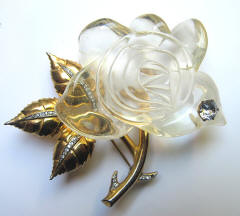
|
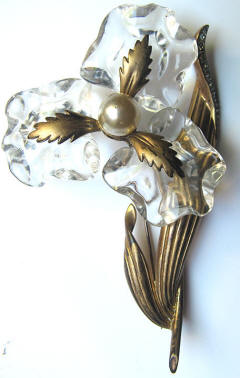
|
|
|
JELLY BELLY
beautifully formed Lucite flower brooch with a clear rhinestone dew drop and
gold tone leaves. View #Bn12 |
JELLY BELLY Lucite 3-petaled flower brooch with a glass pearl center
and gold tone accents. #Bn12b |
|
JEWELRY
DESIGN
Breanda has a wonderful collection of jelly belly brooches, and in
November 2004, she wrote to me:
My husband and I are just back from at trip to New York City. We had the
opportunity to see two fabulous jewelry shows in progress at the
American Folk Art Museum. Both are of fine jewelry.
The first show we saw was "Seaman Schepps – A Century of New York
Jewelry Design." Much of this jewelry was designed from the early
1930s to the late 1950s. He catered to a celebrity clientele from
Hollywood to royalty. The jewelry was often pictured in glamorous photos
in old Vogue magazines.
Over and over, I saw how fine jewelry was the direct inspiration for our
vintage costume jewelry, particularly in Trifari, Coro and even K.J.L.
I had to keep reminding myself that what I was looking at was REAL, as I
have almost line for line copies in vintage costume jewelry. I realized
that my beloved Lucite jelly bellies were copied from figurals
originally done in gold and rock crystal…
|
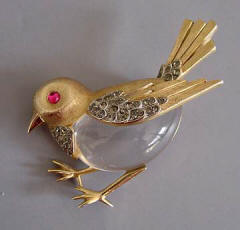 |
One example is the
Trifari jelly belly bird brooch, shown at right. |
TRIFARI “jelly belly” bird brooch in brushed gold tone with
rhinestones.
View #T6116
|
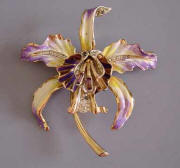 |
.. and the same
is true of pearl bellies, tuttie fruity (which we call fruit salad), and
invisibly set stones. Many of K.J.L.’s (Kenneth J Lane’s) designs look
very similar to Schepp’s jeweled menagerie. Even the stylized Hattie
Carnegie figurals done with orange and green lucite saw their
origination from the designs by Seaman Schepps
The second show (right across the street) was "Masterpieces of
American Jewelry". These fine jewels were by the best of the best –
Tiffany, Cartier, etc. Tiffany did a series of enamel and diamond
orchid brooches in the 1890s, and Coro mimicked them in the enamel and
rhinestone orchid pins they made in the 1940s, like the one shown at the left.
|
CORO sterling vermeil orchid
brooch with purple and yellow enamel and clear rhinestones, circa 1945.
View #C21466 |
|
|
SOURCE
MYTH
For years a story has
circulated that World War II airplane windshields were used to make some of
the jelly belly jewelry. While it is a appealingly romantic story, it is
probably not a true one.
Bobye Syverson comments on this subject, "During World War II, I not
only flew some of the planes but did some of the work on them. The Lucite
in the windshields was �" to �" thick. If damaged, they tended to crack in
a spider web pattern.
"After the war, pieces could be bought in hobby shops to be cut and shaped
into whatever a person wished. I bought some pieces that were quite flat,
cut them out with a jig saw, shaped them by holding them in an oven, drilled
holes to set rhinestones in, and made two crown replicas. The entire base
structure of the crown is Lucite. Since I was using pointed back
rhinestones, I had to drill a cup in which to set each stone. Also, I know that the mechanics that I worked with
would cut out round pieces from discarded wind shields, drill a hole in the
center and make a finger ring as a souvenir for their girl friends.
"All of the pieces that I ever saw
from the planes tended to turn yellowish with time. Because of that, it is my opinion that
the Lucite that was used by the jewelry companies was not the same as that
used for the plane windows."
As Pat Seal says, "Whatever the
true story is, the old jellies will continue to be loved, admired, and
coveted by collectors for many years to come. They are certainly some of my
favorites and it is always a huge thrill to discover one."
|
|
A word of warning to jewelry collectors:
There are many reproductions of Jelly Belly jewelry on the market, both
poorly done and dangerously well done, so be very careful of what you buy as
a vintage Jelly Belly. They should NOT have glass bellies or colored
bellies, for one thing. The frog on a lily pad is just one of the
reproductions, as are
the pins with enameled fruit in them. Also reproduced are the Poodle and
Pekinese and some of the bird designs, as well as several other subjects. Some are
even marked on the back with the names of companies who never made jellies at all,
like Hobe! |
|




